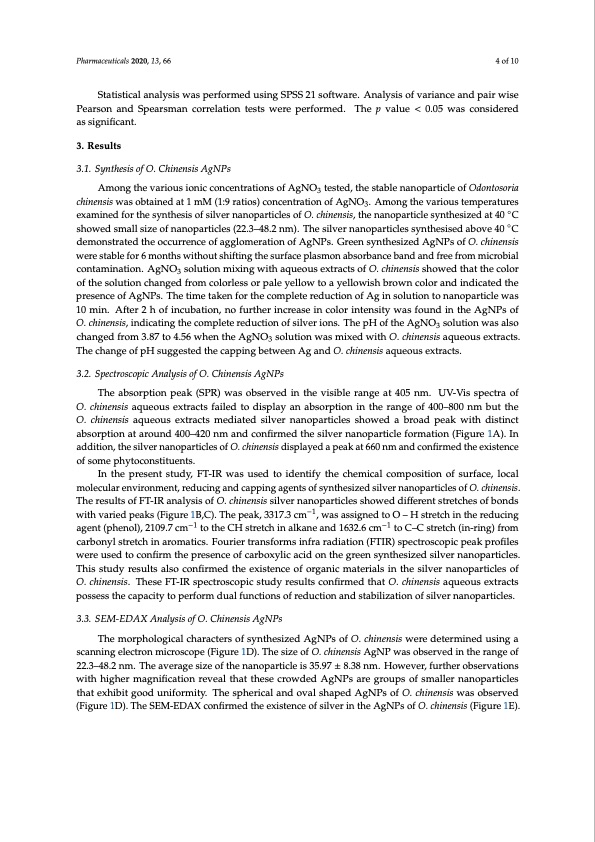
PDF Publication Title:
Text from PDF Page: 004
Pharmaceuticals 2020, 13, 66 4 of 10 Statistical analysis was performed using SPSS 21 software. Analysis of variance and pair wise Pearson and Spearsman correlation tests were performed. The p value < 0.05 was considered as significant. 3. Results 3.1. Synthesis of O. Chinensis AgNPs Among the various ionic concentrations of AgNO3 tested, the stable nanoparticle of Odontosoria chinensis was obtained at 1 mM (1:9 ratios) concentration of AgNO3. Among the various temperatures examined for the synthesis of silver nanoparticles of O. chinensis, the nanoparticle synthesized at 40 ◦C showed small size of nanoparticles (22.3–48.2 nm). The silver nanoparticles synthesised above 40 ◦C demonstrated the occurrence of agglomeration of AgNPs. Green synthesized AgNPs of O. chinensis were stable for 6 months without shifting the surface plasmon absorbance band and free from microbial contamination. AgNO3 solution mixing with aqueous extracts of O. chinensis showed that the color of the solution changed from colorless or pale yellow to a yellowish brown color and indicated the presence of AgNPs. The time taken for the complete reduction of Ag in solution to nanoparticle was 10 min. After 2 h of incubation, no further increase in color intensity was found in the AgNPs of O. chinensis, indicating the complete reduction of silver ions. The pH of the AgNO3 solution was also changed from 3.87 to 4.56 when the AgNO3 solution was mixed with O. chinensis aqueous extracts. The change of pH suggested the capping between Ag and O. chinensis aqueous extracts. 3.2. Spectroscopic Analysis of O. Chinensis AgNPs The absorption peak (SPR) was observed in the visible range at 405 nm. UV-Vis spectra of O. chinensis aqueous extracts failed to display an absorption in the range of 400–800 nm but the O. chinensis aqueous extracts mediated silver nanoparticles showed a broad peak with distinct absorption at around 400–420 nm and confirmed the silver nanoparticle formation (Figure 1A). In addition, the silver nanoparticles of O. chinensis displayed a peak at 660 nm and confirmed the existence of some phytoconstituents. In the present study, FT-IR was used to identify the chemical composition of surface, local molecular environment, reducing and capping agents of synthesized silver nanoparticles of O. chinensis. The results of FT-IR analysis of O. chinensis silver nanoparticles showed different stretches of bonds with varied peaks (Figure 1B,C). The peak, 3317.3 cm−1, was assigned to O – H stretch in the reducing agent (phenol), 2109.7 cm−1 to the CH stretch in alkane and 1632.6 cm−1 to C–C stretch (in-ring) from carbonyl stretch in aromatics. Fourier transforms infra radiation (FTIR) spectroscopic peak profiles were used to confirm the presence of carboxylic acid on the green synthesized silver nanoparticles. This study results also confirmed the existence of organic materials in the silver nanoparticles of O. chinensis. These FT-IR spectroscopic study results confirmed that O. chinensis aqueous extracts possess the capacity to perform dual functions of reduction and stabilization of silver nanoparticles. 3.3. SEM-EDAX Analysis of O. Chinensis AgNPs The morphological characters of synthesized AgNPs of O. chinensis were determined using a scanning electron microscope (Figure 1D). The size of O. chinensis AgNP was observed in the range of 22.3–48.2 nm. The average size of the nanoparticle is 35.97 ± 8.38 nm. However, further observations with higher magnification reveal that these crowded AgNPs are groups of smaller nanoparticles that exhibit good uniformity. The spherical and oval shaped AgNPs of O. chinensis was observed (Figure 1D). The SEM-EDAX confirmed the existence of silver in the AgNPs of O. chinensis (Figure 1E).PDF Image | Synthesis of Silver Nanoparticles Using Odontosoria chinensis

PDF Search Title:
Synthesis of Silver Nanoparticles Using Odontosoria chinensisOriginal File Name Searched:
pharmaceuticals-13-00066-v2.pdfDIY PDF Search: Google It | Yahoo | Bing
Turbine and System Plans CAD CAM: Special for this month, any plans are $10,000 for complete Cad/Cam blueprints. License is for one build. Try before you buy a production license. More Info
Waste Heat Power Technology: Organic Rankine Cycle uses waste heat to make electricity, shaft horsepower and cooling. More Info
All Turbine and System Products: Infinity Turbine ORD systems, turbine generator sets, build plans and more to use your waste heat from 30C to 100C. More Info
CO2 Phase Change Demonstrator: CO2 goes supercritical at 30 C. This is a experimental platform which you can use to demonstrate phase change with low heat. Includes integration area for small CO2 turbine, static generator, and more. This can also be used for a GTL Gas to Liquids experimental platform. More Info
Introducing the Infinity Turbine Products Infinity Turbine develops and builds systems for making power from waste heat. It also is working on innovative strategies for storing, making, and deploying energy. More Info
Need Strategy? Use our Consulting and analyst services Infinity Turbine LLC is pleased to announce its consulting and analyst services. We have worked in the renewable energy industry as a researcher, developing sales and markets, along with may inventions and innovations. More Info
Made in USA with Global Energy Millennial Web Engine These pages were made with the Global Energy Web PDF Engine using Filemaker (Claris) software.
Infinity Turbine Developing Spinning Disc Reactor SDR or Spinning Disc Reactors reduce processing time for liquid production of Silver Nanoparticles.
| CONTACT TEL: 608-238-6001 Email: greg@infinityturbine.com | RSS | AMP |